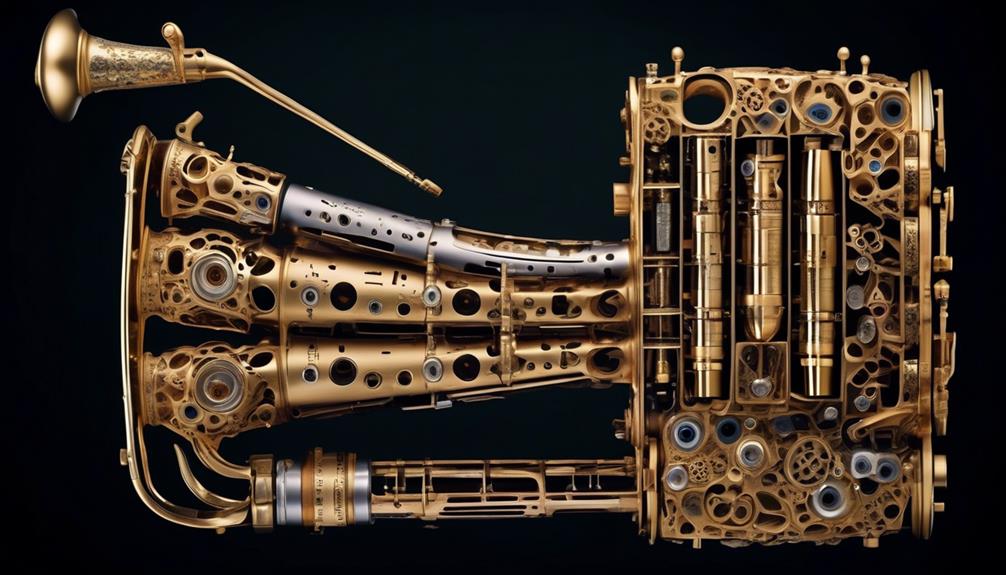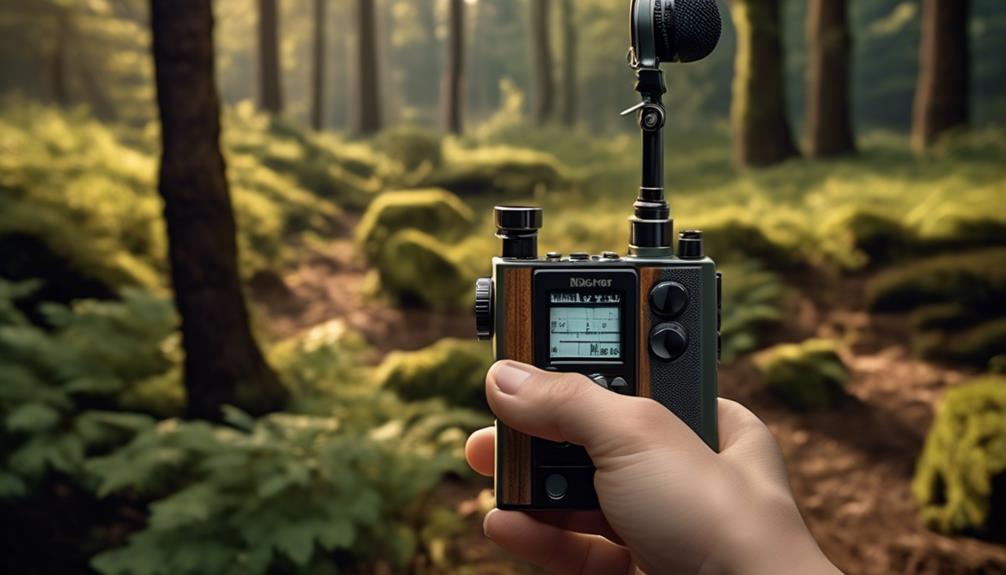Have you ever thought about what causes that unique sound in a recorder? It’s not just about blowing into a tube and making noise. The physics and mechanics at play here are truly fascinating.
Understanding the inner workings of a recorder's sound production can provide insight into the complexities of musical instruments and the human capacity for creating music. As we explore the intricate process of how a recorder generates its sound, we'll uncover the surprising elements that contribute to its unique tonal quality and versatility.
Key Takeaways
- Blowing air into the windway and across the labium produces the sound in a recorder.
- The resonance of the air column inside the instrument regulates the recorder's pitch.
- Controlled air pressure and precise fingering techniques are essential skills for recorder players.
- The shape and length of the air column inside the recorder significantly impact the sound produced.
Anatomy of a Recorder's Sound Production
Blowing air into the windway and across the labium produces the sound in a recorder. This simple yet intricate process sets the stage for the mesmerizing tones that can be coaxed from this instrument.
As the air is directed across the labium, it sets standing waves in motion within the recorder's bore, resulting in the creation of sound waves. The regulation of pitch is a fascinating interplay of physics and artistry, as the resonance feedback of the tube determines the final note heard. It's akin to the air column inside the recorder behaving like a vibrating string, with its own set of modes of vibration, adding to the complexity of the produced sound.
When playing a recorder, the technique involves a delicate dance of covering and uncovering fingerholes. This manipulation allows for the production of different notes and effects, showcasing the versatility of this instrument. The combination of precise finger placement and controlled breath yields the beautiful, clear tones that define the sound of the recorder.
Truly, the anatomy of a recorder's sound production is a marvel to behold and master.
The Role of Air in Recorder Sound

As we explore the intricate workings of a recorder's sound production, the pivotal role of air in shaping the instrument's tonal qualities becomes increasingly apparent. The air's journey through the windway and across the labium is crucial for creating standing waves within the recorder's bore, which in turn produce the instrument's sound. Understanding the influence of air in recorder sound involves a deep grasp of several essential factors:
- The resonance of the air column inside the instrument, akin to the vibration of a string, is fundamental in regulating the recorder's pitch.
- Controlled air pressure and release, as well as precise fingering techniques specific to different types of recorders, are essential skills for any recorder player striving for mastery.
- The speed of air and tongue articulation play a significant role in controlling the pitch, volume, and articulation of the recorder sound, demanding a high level of skill and precision.
- Mastery also involves understanding self-noise and its influencing factors, such as the proximity of the sound to the microphone and the signal-to-noise ratio.
Understanding and mastering the role of air in recorder sound production is crucial for any serious recorder player, as it's intricately linked to the instrument's tonal qualities and expressive capabilities.
Understanding Recorder Resonance
Understanding the recorder's resonance involves considering the vibration of air inside the instrument and its influence on the resulting sound. When exploring the resonance of a new recorder, it's crucial to recognize that the shape and length of the air column within the instrument significantly impact the sound produced.
The material and construction of the recorder also play a pivotal role in determining its resonance and the overall quality of the sound it produces. Moreover, the manipulation of resonance in a recorder can be achieved through different fingerings and breath pressure, enabling the production of various tones and dynamics.
Additionally, the design of the recorder's windway and labium is essential in shaping its resonant characteristics. As we delve into understanding recorder resonance, it becomes evident that these factors collectively contribute to the instrument's ability to produce a rich and diverse range of sounds.
As enthusiasts seeking mastery, it's essential to comprehend these elements to fully appreciate and harness the potential of the recorder's resonance.
Exploring Recorder Acoustics

Exploring the recorder's acoustics reveals the intricate interplay of air, vibrations, and sound production within the instrument's bore. As recorder players, understanding the acoustics of our instrument is crucial for mastery. Here are some key aspects to consider when exploring recorder acoustics:
- The windway and labium: These components are where the magic begins, as air is blown into the windway and across the labium to create the initial vibrations that lead to sound production.
- Resonance and pitch regulation: The feedback from the resonance of the tube regulates the pitch, and the air column inside the instrument behaves like a vibrating string with multiple modes of vibration, influencing the pitch we produce.
- Finger technique: Our hand positioning and finger movements play a critical role in covering and uncovering fingerholes sequentially, affecting pitch, volume, and articulation patterns.
- Air pressure and mouth shape: Understanding how minimal air pressure is needed to produce sound and how the mouth and throat shape can influence tone and timbre is essential for achieving desired sound quality.
- Fingering techniques: Mastering various fingering techniques, such as forked fingerings, partial hole coverings, and covering the bell, allows for the production of different notes and effects on the recorder.
Evolution of Recorder Sound Technology
The intricate interplay of air, vibrations, and sound production within the recorder's bore has driven significant advancements in recorder sound technology over the years. These developments have focused on enhancing the instrument's tonal range, playability, and overall sound quality. One of the key areas of evolution has been the refinement of the bore design and material selection to achieve optimal acoustics. Additionally, advancements in manufacturing processes have allowed for greater precision in the construction of recorders, resulting in instruments that offer improved consistency and resonance across their entire range.
| Aspect of Evolution | Description | Impact |
|---|---|---|
| Bore Design | Utilizing computer-aided design for intricate bore shapes | Enhancing the instrument's tonal range and projection |
| Material Selection | Experimenting with various woods and synthetic materials | Improving the overall sound quality and stability |
| Manufacturing Processes | Incorporating advanced machining and quality control | Ensuring access to the full, lowest note and consistent playability |
These advancements have not only broadened the recorder's tonal palette but also provided musicians with greater access to the full range of the instrument, including the lowest note, resulting in a more versatile and expressive musical tool.
Frequently Asked Questions
What Creates the Sound of a Recorder?
We create the sound of a recorder by blowing air into the windway and across the labium. This action generates standing waves in the bore, producing sound waves.
The pitch is regulated by the feedback from the resonance of the tube. Recorder technique involves controlling the start and end of notes with tongue articulation and covering and uncovering fingerholes.
The recorder requires very little air pressure to produce sound, and the speed and control of air affect the pitch and volume of the recorder sound.
What Makes a Recorder Squeak?
Squeaking in a recorder occurs when the air passing through the windway hits the labium, causing turbulence and a high-pitched sound. This happens due to factors like high air pressure or unsteady breath.
Maintenance is crucial to prevent irregular air flow. Proper cleaning and ensuring no moisture or debris is present can help.
Mastery of breath control and technique is essential to minimize and control the noise, resulting in clear and controlled sound production.
What Is the Science Behind the Recorder?
Sound production in a recorder involves the blowing of air across a sharp edge, causing air inside to vibrate and produce sound waves.
The pitch is regulated by the feedback from the resonance of the tube. Air pressure, controlled by uncovering fingerholes and partial covering, affects both pitch and volume.
Mouth and throat shape, along with tongue articulation, influence the tone.
This intricate process creates the distinct sound of a recorder.
How Does a Recorder Vibrate?
When air flows through a recorder, it vibrates due to the interaction between the air column and the instrument's design. These vibrations, similar to ripples on a pond, create sound waves.
The recorder's acoustic resonance, resulting from the feedback of the vibrating air column and the instrument's tube, helps sustain these vibrations and produce the sound we hear.
Understanding how recorder vibrations and acoustic resonance work is essential for mastering the instrument.
Conclusion
So, after conducting our investigation, we can confirm that the noise in a recorder is a result of the air being blown into the windway and across the labium, creating standing waves in the bore of the recorder.
The pitch of the sound is regulated by the feedback from the resonance of the tube, and the technique of covering and uncovering fingerholes in a specific sequence also plays a significant role in producing the distinct sound of a recorder.










